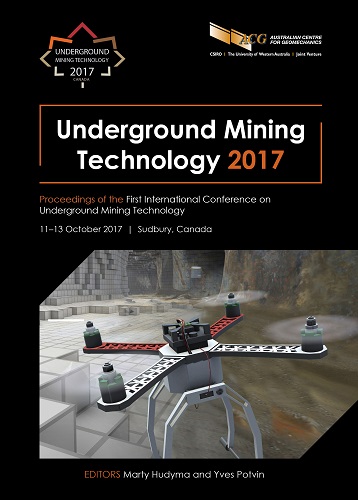Capture of images in inaccessible areas in an underground mine using an unmanned aerial vehicle

|
Authors: Freire, GR; Cota, RF |
DOI https://doi.org/10.36487/ACG_rep/1710_54_Freire
Cite As:
Freire, GR & Cota, RF 2017, 'Capture of images in inaccessible areas in an underground mine using an unmanned aerial vehicle', in M Hudyma & Y Potvin (eds), UMT 2017: Proceedings of the First International Conference on Underground Mining Technology, Australian Centre for Geomechanics, Perth, https://doi.org/10.36487/ACG_rep/1710_54_Freire
Abstract:
Underground operation is a complex mining method where safety, stability, and ore recovery issues, among other factors, could be an obstacle to operations. In most cases, a simple review of the site could help engineers to understand and solve the problems. To create this overview, many types of images captured were considered. The non-entry mining method used at Cuiabá mine does not allow people to enter the stopes after blasting. The only way to obtain images after blasting is by using drones or other unmanned aerial vehicles (UAVs) fitted with cameras. The difficulties for this type of project include lighting, highdefinition image capture, and access. Remote access in areas mined by the sublevel method at the Cuiabá mine is only possible with a UAV that is equipped with technology that can film with effective illumination. In addition, the equipment should be able to fly without the aid of GPS, fly at variable low speed to withstand small shocks with the rock wall and support elements, and often fly without visual contact with the pilot. Furthermore, the UAV controls must be easy enough for mine site employees to use with limited training and knowledge of aeronautics. For this purpose, a hybrid equipment was designed, using a helium gas filled balloon, with remote controlled quadcopter propellers, powerful LED lighting, rechargeable batteries, remote controlled cameras, image stabiliser, and radio frequency transmitters for control and image visualisation. A number of other solutions have been customised in the device to avoid problems inherent in mine operation. In countless trails, the UAV presented images that helped the local team change projects, reconsider pillar sizes, find ore trapped inside the stopes, and identify other important situations allowing an increase in safety and production.
Keywords: unmanned aerial vehicles, non-entry mining method, images, safety, remote access
References:
Freire, GR 2016, ‘Analysis of the top down and bottom up methods and their effects on the deepening of the Cuiabá mine, SabaráMG’, Proceedings of the VII Brazilian Symposium on Rock Mechanics, International Society for Rock Mechanics, Lisbon.
© Copyright 2025, Australian Centre for Geomechanics (ACG), The University of Western Australia. All rights reserved.
View copyright/legal information
Please direct any queries or error reports to repository-acg@uwa.edu.au
View copyright/legal information
Please direct any queries or error reports to repository-acg@uwa.edu.au